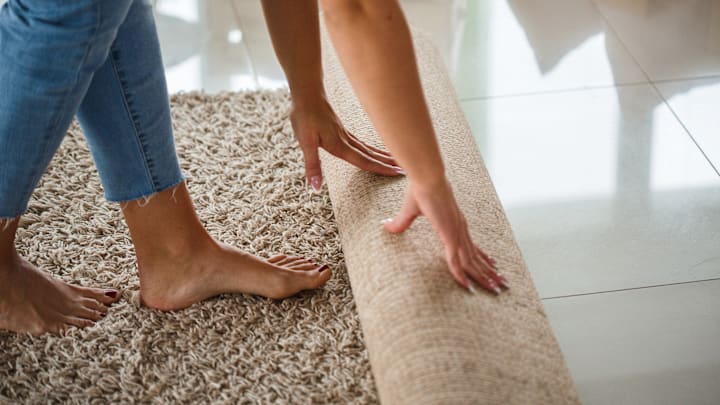It’s funny how one signature piece—whether it’s an artsy new wall hanging, a chic accent chair, or a new bedspread—can end up changing the whole look and feel of a room. Sometimes, adding a splash of color or a few well-placed design elements are all you really need to tie it together. So even if you’re not ready for a full-on room renovation project, simply adding an accent or area rug can go a long way toward bringing a drab room back to life. From choosing the right size, shape, material, and color to keeping it clean, here are seven easy tips from Roborock and Mental Floss for choosing the best rug for your space.
1. Figure out what sort of atmosphere you’re going for.
Start by thinking about why you’re adding a new rug in the first place—is it just to cover up some chilly flooring and make the room cozier, or is there a certain design or color scheme you’re trying to coordinate with the rest of your furniture? Do you want the space to be more calming or the center of all the action? Are you thinking of purchasing a smaller accent rug to provide a subtle pop of color, or a larger area rug to make a bold statement? Having those questions answered will make choosing the right rug much easier.
You also don’t want to overdo it with too many different colors or patterns, which may end up clashing. So as you continue to imagine and plan out your space, consider the kinds of colors, textures, and other design-forward features that are already in it. Collect samples, if possible, or create a mood board that encompasses your current tones to get a better idea of what colors may work best together.
2. Pick the perfect size for your space.
The right rug should help pull a room together, not overwhelm it. Make sure you’ve got the measurements for the space you want to cover, and note the location of different pieces of furniture—beds, couches, and dining room chairs—so each item has its own breathing space, so to speak. Some experts recommend having an 8-to-12-inch perimeter around living room furniture, an extra 24 inches to play with in bedrooms, and enough room around the edges—ideally 3–6 inches—when laying out a rug in other parts of the house.
3. Choose a shape that makes sense.
It all comes back to the overall vibe and aesthetic you’re going for. Many rugs are available in a rectangle, square, or oval, though you’re by no means limited to those shapes—opting for a circle or another unique design (like a semi-circle, heart, or star) will make it really stand out. Also keep in mind that accent rugs tend to be smaller (in the 2-feet-by-3-feet to 4-feet-by-6-feet range), while area rugs are meant to cover a larger space (in the 5-feet-by-8-feet to upwards of 8-feet-by-10-feet range).
4. Consider the material it’s made of ...
There is a correlation between the fabric your rug is made of and how easy it will be to keep clean. If you’re looking for something light and airy that can be easily spot-cleaned, stick to natural plant fibers like sisal and jute or synthetic fibers like viscose (rayon), nylon, and polyester. Other materials, like acrylic blends and cotton, can also be washed by hand or carefully in the washing machine. Be extra careful with wool rugs, which should be vacuumed on a regular basis to control any natural shedding.
5. … and the rug’s pile height.
You’ll also want to make sure you’re choosing the right pile height for your space: Low pile tends to be a quarter-inch or less; medium up to half an inch; and high can be three-quarters of an inch (or even greater). In general, thicker doesn’t necessarily equal better; low-pile rugs will often last longer, and they’re easier to clean, making them ideal for high-traffic areas like hallways. Medium pile rugs provide a bit more cushion underfoot and work best in dining and living rooms as well as bedrooms. High pile rugs are very cozy, but they’re higher maintenance: Not only can furniture legs crush the pile, but these rugs can also hold on to more dirt.
6. Make sure it’s easy to clean.
With everything else going on in our busy lives, finding a rug that’s easy to clean is key: Not only does a clean rug look better; consistent cleaning will help it last longer. You might want to consider investing in a robot vacuum to help keep up with rug maintenance so that you’re properly protecting your investment. (Let’s face it: Rugs aren’t cheap!).
7. Invest in a rug pad to keep it from sliding.
If you’re putting a rug over hardwood floors, placing a rug pad underneath will help to prevent it from sliding around, counter the effects of foot traffic, protect your floor from being scratched, help absorb noise, and make it easier to vacuum. They also help extend the life of your rug. Just make sure it’s slightly smaller than your accent or area rug—ideally about an inch less on all sides—so it doesn’t stick out. Aim for one with a non-slip coating (for the side facing your floors), or, if you’re covering a carpet, ensure it has a coated adhesive made of polyester fabric to prevent any colors from your new rug from bleeding through.
Tackle tall thresholds and high-pile rugs with Roborock’s new Qrevo Curv. This elegant, innovative robot vacuum is equipped with an industry-first AdaptiLift Chassis, which allows it to easily navigate thresholds up to 1.5 inches. Plus, its Dual-Anti Tangle System helps guide and sweep hair into the dustbin without getting stuck or tangled on the brushes.From September 30 to October 6, you can nab the Qrevo Curv for 13 percent off (that’s a $200 discount!) on Roborock’s official website—and get a Dyad Air vacuum for free.
